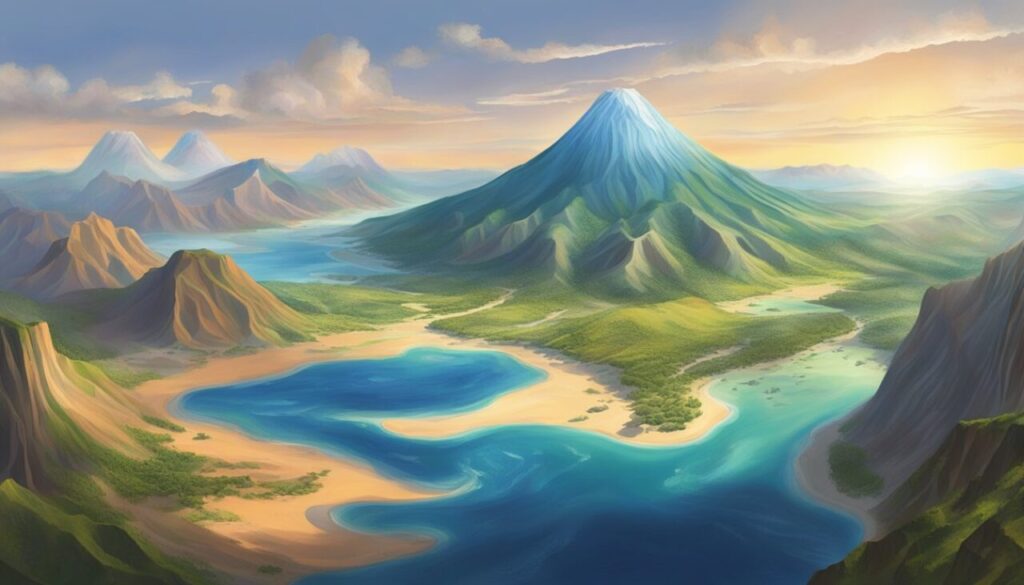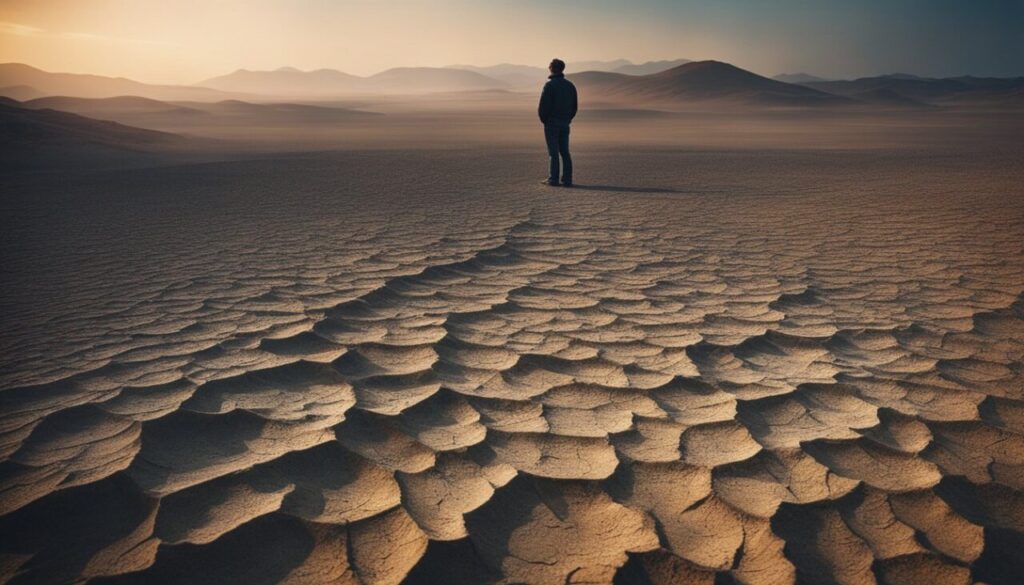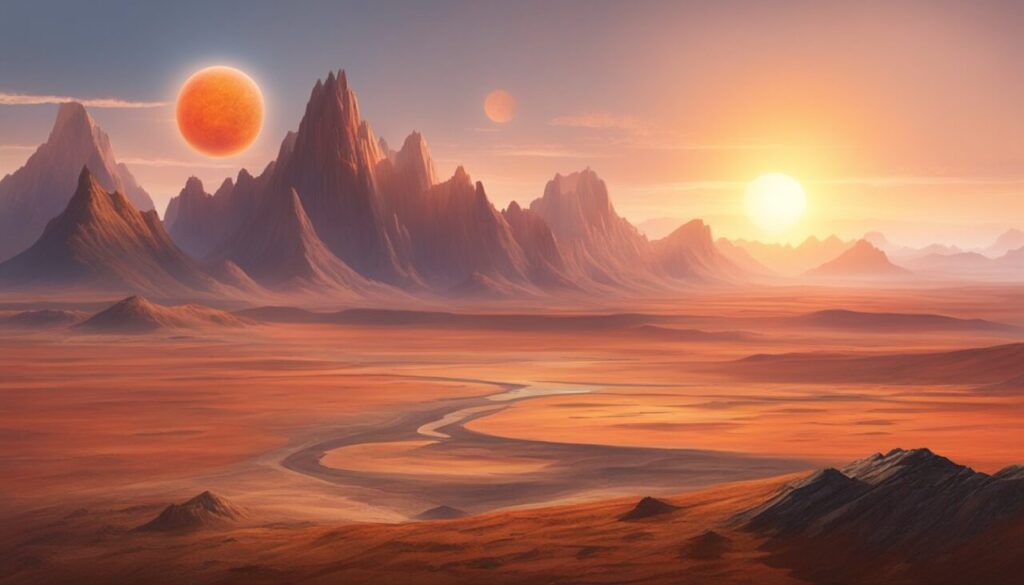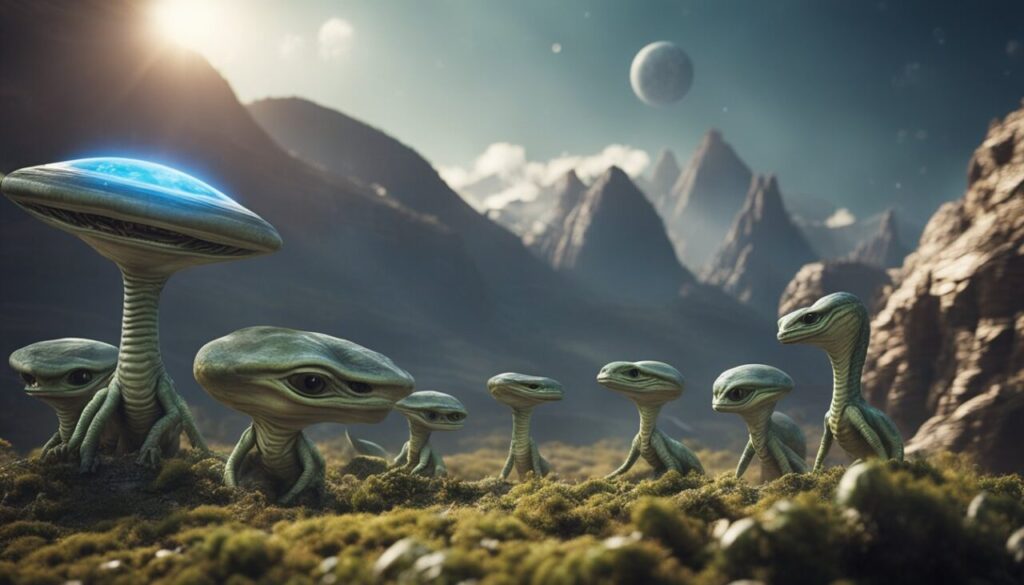
Earth is a very dynamic planet that has undergone significant changes over its 4.54 billion years of existence. From the formation of the first supercontinent to the evolution of complex life forms, Earth went through it all.
Nonetheless, we humans always wonder, and we often enjoy directing our wonderings into the future.
And so, this time we ask ourselves the following question:
What Will Earth and Life Look Like in One Billion Years?
While no one can predict the future with certainty, scientists have made science-backed predictions about how the planet will change over the next billion years.
According to research, in about one billion years, the solar luminosity will increase by 10%, causing the atmosphere to become a “moist greenhouse.”
This increase in heat will result in the evaporation of the oceans, and the Earth will become uninhabitable for most forms of life.
Interesting fact: Due to an increase in luminosity, Earth may become uninhabitable, while Mars will move into the habitable zone. Specifically, Earth will become too hot, and Mars will change from being too cold to just hot enough.
This prediction is based on the assumption that the Earth’s climate will continue to follow the same pattern as it has in the past. However, there are still many unknown factors that could influence the planet’s future, making it challenging to predict with certainty.
Therefore, to explore the future, it is essential to delve into the past as well.
So, let’s go back in time.
Related:
How Did Earth Look Like 1 Billion Years Ago?

One billion years ago, Earth looked very different from what it does today. The planet was still in the Proterozoic Eon, which lasted from 2.5 billion years ago until 541 million years ago. During this time, the Earth experienced significant changes in its geology and atmosphere.
One of the most notable differences between Earth one billion years ago and today is the presence of oxygen in the atmosphere. At that time, the atmosphere was primarily composed of nitrogen, carbon dioxide, and methane.
The oxygen levels were much lower than they are today, making it difficult for most multicellular organisms to survive.
The continents were also arranged differently.
One billion years ago, the supercontinent Rodinia had formed and was beginning to break apart.
This led to the formation of smaller continents, such as Laurentia and Baltica. The continents were still moving and colliding, leading to the formation of mountain ranges and other geological features.
In terms of life, one billion years ago, the Earth was home to a variety of single-celled organisms, such as photosynthetic eukaryotes, cyanobacteria, algae, and protozoans.
These organisms played a crucial role in shaping the Earth’s atmosphere and paving the way for more complex life forms.
Key Aspects of Earth 1 Billion Years Ago – The Table
Before going further trying to predict the future of Earth in 1 Billion Years let’s first summarize important aspects of Earth 1 Billion Years Ago:
| Aspect | Information |
| Geological Era | Proterozoic Eon: 2.5 billion to 541 million years ago. |
| Atmosphere Composition | Predominantly composed of nitrogen, carbon dioxide, and water vapor. Oxygen levels were much lower than today. |
| Climate | Earth experienced a “Snowball Earth” phase with widespread glaciations. However, there were intervals of warming during this period. |
| Continental Configuration | Supercontinents like Rodinia were forming and breaking apart. Continents were smaller and scattered. |
| Oceans | Oceans existed but were likely shallower than today. The first multicellular life forms were evolving, including algae and early animals. |
| Biosphere | Simple multicellular organisms were present, such as soft-bodied animals, algae, and some complex microbial life. |
| Life Forms | Early eukaryotic cells evolved around this time. The first animals with hard parts, like shells, started to appear. |
| Tectonic Activity | Active tectonic processes, with volcanic activity and the formation of mountain ranges. Plate tectonics played a role in shaping Earth’s surface. |
| Day Length | The day was shorter, with estimates ranging from 18 to 20 hours per day due to the Earth’s gradual slowing rotation. |
| Solar Output | The sun’s output was about 6-10% less than it is today, leading to a cooler Earth. |
And so, before delving into different aspects of changes in 1 billion years, first, we need to ask ourselves – will we still be here? Will humanity endure?
Probability of Humans to Still be Alive on Earth in 1 Billion Years?

The probability of humans still existing on Earth in 1 billion years is relatively low to medium given the changes that will occur on the planet.
Humans have only been around for a relatively short period of time, and it is uncertain whether we will be able to adapt to the changes that will occur on the planet.
It is possible that new forms of life will evolve that are better suited to the changing environment.
Nonetheless, let’s do some basic calculations based on several assumptions and let’s try to calculate the probability of human survival.
Keep in mind this is rather a simplistic view as there are thousands of (unpredictable) factors influencing potential human survival in 1 billion years.
So let’s use the following five factors:
Factors:
- Surviving an Asteroid Impact (Pasteroid): With a probability of 0.8 (80%), our ability to endure a catastrophic asteroid impact is relatively high. This factor accounts for the potentially devastating consequences that large celestial bodies colliding with Earth may bring. In the future, we’ll probably have even more advanced technologies to firstly avoid asteroid impacts and, if they occur, to survive them.
- Avoiding Nuclear War (Pnuclearwar): The probability assigned here is 0.7 (70%), reflecting the global efforts and diplomatic initiatives aimed at preventing large-scale nuclear conflicts, but also taking into consideration that humans are constantly in some kind of conflict.
- Adapting to Environmental Changes (Penvironment): Assigned a probability of 0.85 (85%), this factor encompasses our capacity to adapt to environmental shifts, including climate change. It acknowledges the resilience of the human species in the face of changing planetary conditions.
- Technological Advancements Preventing Existential Risks (Ptech): At 0.80 (80%), this factor represents our reliance on technological progress to mitigate existential risks.
- Surviving Supervolcano Events (Psupervolcano): Considering the potential impact of supervolcano eruptions, this factor is assigned a probability of 0.9 (90%). In the next billion years, Earth will certainly witness several supervolcano eruptions but humanity will likely survive those.
And so with all these factors we have the following:
Ptotalsurvival = Pasteroid×Pnuclearwar×Penvironment×Ptech×Psupervolcano
Ptotalsurvival = 0.80×0.70×0.85×0.80×0.90
Ptotalsurvival ≈ 0.342
And so, in this simplistic scenario, the combined probability of humanity surviving the specified risks is approximately 34.2%.
Of course, this exercise remains highly speculative and does not encompass the full complexity of factors influencing humanity’s long-term survival.
For example, if we consider the added complexity of survival in the case of disappeared oceans due to increased sun luminosity, our probability of survival on this planet drops below 10%.
Okay, so let’s now delve into different changes that will happen on Earth in 1 billion years, starting with continental changes that will be rather obvious.
Continental Drift and Plate Tectonics
The movement of Earth’s tectonic plates and the resulting continental drift have been shaping the planet’s surface for billions of years.
Plate tectonics is the scientific theory that explains how the Earth’s outer layer is made up of several plates that move and interact with each other.
The movement of these plates is driven by the flow of molten rock in the Earth’s mantle, which causes the plates to slowly move apart or collide with each other.
Supercontinent Cycles

Over the past 3 billion years, the Earth’s continents have come together to form several supercontinents, which later broke apart and formed new continents. The most recent supercontinent was Pangea, which existed about 300 million years ago.
Interesting fact: During Earth's history there have been a total of seven supercontinents.
According to a study by geologists, the next supercontinent will form in the antipodes of Pangea, with the Americas colliding with the northward drifting Antarctica, and then into the already collided Africa-Eurasia.
And this will probably happen much earlier than 1 billion years.
For example, we can expect that Pangaea Ultima / Proxima or the Next Supercontinent will form around 250 million years from now.
And continent formation is directly tied with formation of mountains.
Mountain Formation

When two tectonic plates collide, the pressure and heat generated by the collision can cause the rocks to fold and buckle, resulting in the formation of mountains.
The Himalayas, for example, were formed when the Indian Plate collided with the Eurasian Plate about 50 million years ago.
The collision is still ongoing, and the Himalayas are still growing at a rate of about 1 cm per year.
However, this rate of growth will decrease and the Himalayas might look completely different in 1 billion years if they will even exist.
Interesting thought: Based on the abovementioned pace of growth, the Himalayas would grow 10 km in a million years. However, this will not happen, as it is more likely that the Himalayas will be stretching out.
One thing is certain – there will be enormous changes in mountain ranges in the next 1 billion years. Some will disappear, all will change, and Earth will witness the creation of new mountain ranges.
For instance, the Appalachian Mountains formed directly due to the consolidation of all continents into the supercontinent Pangea as the Iapetus Ocean closed approximately 290 million years ago.
The same process will happen several times in the next 1 billion years.
And this brings us to the volcanic activity in the future.
Volcanic Activity
Volcanic activity is closely related to plate tectonics. When two plates collide, one plate is often forced beneath the other, a process known as subduction.
As the subducting plate sinks into the Earth’s mantle, it releases water and other volatile substances, which can cause the overlying plate to melt and form magma.
This magma can then rise to the surface and erupt as a volcano.
The Pacific Ring of Fire, a region of intense volcanic and seismic activity around the Pacific Ocean, is a prime example of subduction-related volcanic activity.
And so, out of more than 1000 known volcanoes, around 20 are supervolcanoes, and we can expect numerous eruptions in the next billion years.
Related: What Would Happen If Yellowstone Erupted?
Some of these eruptions might drastically alter life on Earth.
This leads us to the broader alterations in climate.
We have previously discussed the sun’s gradual increase in brightness, rising by approximately 10% over each billion years while it consumes burning hydrogen.
Now, let’s explore more climate and atmospheric details.
Climate Change and Atmospheric Evolution

Greenhouse Effect
In the next billion years, Earth will experience significant changes in climate due to various factors, including the greenhouse effect. As the Sun’s luminosity increases, the Earth’s temperature will rise, causing more water to evaporate from the oceans and leading to a higher concentration of water vapor in the atmosphere.
This will intensify the greenhouse effect, further warming the planet and leading to more extreme weather patterns.
Note: See the consequences of oceans disappearing in our article ‘What If The Oceans Dissapeared’.
In short, the consequences of oceans disappearing will be dreadful.
Biological Evolution and Extinction
Species Diversification
Over the course of Earth’s history, life has diversified and evolved to adapt to changing environmental conditions. The process of speciation has given rise to a vast array of organisms, from single-celled bacteria to complex multicellular animals.
In the next billion years, it is likely that new species will continue to emerge as they adapt to changing environmental conditions.
One potential driver of speciation is geographic isolation, which can lead to the formation of new species over time.
As tectonic plates continue to shift and continents drift apart, it is certain that new landmasses will form, creating new habitats for life to colonize and diversify.
One possible scenario is that the harsher conditions on Earth, such as increased temperatures and more extreme weather events, may lead to the emergence of species that are better adapted to these conditions.
For example, some species may evolve to be more heat-resistant or drought-tolerant.
Mass Extinctions
While speciation has led to the diversification of life on Earth, mass extinctions have also played a significant role in shaping the planet’s biodiversity. Over the past 500 million years, there have been five major mass extinctions, each wiping out a significant proportion of the planet’s species.
The most recent mass extinction, which occurred around 66 million years ago, wiped out the dinosaurs and many other species. While the cause of this extinction event is still debated, it is widely believed to have been triggered by a massive asteroid impact.
In the next billion years, it is probable that Earth will witness several mass extinction events. While it is difficult to predict the exact cause of such events, potential triggers could include volcanic activity, climate change, or another asteroid impact.
And so with that, let’s explore some of the astronomical factors that will impact Earth in next 1 billion years.
Astronomical Factors

Milky Way Trajectory
In 1 billion years, the Milky Way galaxy will have completed one orbit around the center of the Local Group of galaxies.
The Local Group consists of the Milky Way, Andromeda, and about 34 other smaller galaxies. The Milky Way is currently moving towards the Andromeda galaxy, and the two galaxies are expected to collide in about 4,5 billion years.
However, the exact path of the Milky Way is difficult to predict due to the complex gravitational interactions between the galaxies in the Local Group.
Solar System Changes
Over the next billion years, the Sun will continue to undergo changes that will affect the Earth. As mentioned, the Sun’s luminosity will gradually increase, causing the Earth’s temperature to rise.
In about 600 million years, the Earth will experience a runaway greenhouse effect, causing the oceans to evaporate and the surface temperature possibly to reach over 1,000 °F (538 °C).
In addition, the positions of the planets in the Solar System will change over time.
The gravitational pull of Jupiter and Saturn will cause the orbits of the other planets to shift slightly.
Note: See the consequences of Jupiter disappearing in our article ‘What Would Happen If Jupiter Disappeared?’.
In about 250 million years, the Earth’s orbit will be slightly more elliptical, causing more extreme seasons.
Overall, the astronomical factors that will affect the Earth over the next billion years are complex and difficult to predict with certainty.
However, scientists can make reasonable predictions based on our current understanding of astronomy and physics.
One thing is certain – Earth will be vastly different planet in 1 billion years and potentially completely uninhabitable planet.
For example, the runaway greenhouse effect is believed to have occurred on Venus, leading to its extremely high temperatures and inhospitable conditions. The process likely began with the increase of greenhouse gases in the planet’s atmosphere, such as carbon dioxide.
As Venus warmed, more water vapor entered the atmosphere, creating a positive feedback loop that further increased the greenhouse effect.
The runaway greenhouse effect on Venus resulted in a surface temperature hot enough to melt lead, reaching an average of 864 degrees Fahrenheit (462 degrees Celsius).
And so, it is clear that with such conditions, Venus is a completely uninhabitable planet.
Similarly, this could happen to Earth in the next 1 billion years.
And this leads us to the final factor before concluding, and this factor could change the whole trajectory.
Yes – we are talking about us (humans) and potential unimaginable technological advancements.
Technological Advancements and Space Exploration

As technology advances, humans will continue to explore the vast expanse of space and make new discoveries.
If we do not destroy ourselves, we will certainly colonize other planets, driven not by curiosity but out of pure necessity and survival.
As mentioned, it is likely that Earth will become an uninhabitable planet within the next billion years, and thus space exploration will become the most important endeavor for human survival in the universe.
Moreover, during the course of a billion years, it is probable that humans (or whatever form intelligent beings take) will achieve unimaginable technological advancements.
Perhaps we will become a Kardashev scale Type VII civilization (K7), which would imply the ability to control energy on a multiverse level.
In that case, none of the changes on Earth will matter.
At least not for us humans.
Perhaps, if we become such an advanced civilization, we will be even able to save the Earth with some kind of ultra-advanced technology capable of protecting the whole planet.
Think of it in the following way: just as we can protect our houses today and create the temperature of our living spaces as we wish, perhaps we will be able to do so for the whole planet or even the entire galaxy.
A hypothetical Type 7 civilization could have godlike abilities, and in that case, nothing is unimaginable.
Literally nothing!
Conclusion

In summary, based on the current scientific understanding, Earth will look very different in 1 billion years. The continents will continue to shift and collide, forming a new supercontinent. The sun’s increasing luminosity will cause Earth’s oceans to evaporate, making it uninhabitable for most forms of life.
However, it’s important to note that these are just predictions based on current scientific knowledge and models, and there is always the possibility of unforeseen events or discoveries that could change our understanding of Earth’s future.
Perhaps humans will destroy the Earth, and perhaps humans will actually save the Earth and the whole galaxy.
We modern humans have been on Earth for 300 thousand years, and most changes (from the human & technology perspective) have happened in the last 100 years.
So, what will happen in the next billion years is rather hard to predict, but some categories on a larger scale will probably follow the standard laws of physics, which could be predicted on such a large time scale.
Despite the uncertainty, it’s clear that Earth will continue to change and evolve over time, and it’s up to us to try to take care of our planet.
Note: If you liked this article you might also like:



























